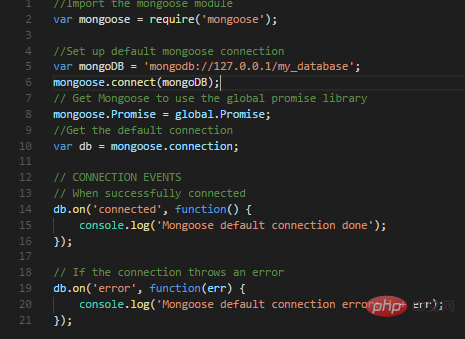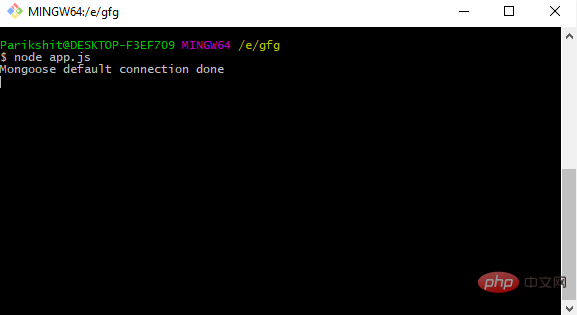NodeJS|Connect MongoDB with Node using MongooseJS
Before we delve into mongoDB how to use mongooseJS to connect with nodejs applications, let’s briefly introduce the mainstream technologies in today’s web development field.

Node: Node.js (Node) is an open source development platform for executing JavaScript code on the server side. Node is useful for developing applications that require a persistent connection from the browser to the server, often used for real-time applications such as chat, news feeds, and web push notifications.
mongoDB: mongoDB is a cross-platform, open source document-oriented database and a NoSQL database. As a NoSQL (not just SQL) database, MongoDB eschews the table-based structure of relational databases to accommodate JSON-like documents that have a dynamic schema it calls BSON (Binary JSON).
MongooseJS: Mongoose or MongooseJS is a MongoDB Object Modeling (ODM) tool designed to work in an asynchronous environment. Basically, it is a package that we will use to interact (query, update, operate) with MongoDB database in nodeJS application. We will use NPM (Node Packaging Manager) to install or "require" mongooseJS in our application.
NPM: Node Package Manager or NPM is the official package manager for nodeJS applications. It will be installed together with NodeJS. It is used from the command line or terminal (depending on what operating system is used).
Now that we are familiar with the basic definitions of these technologies, let’s dive into the code and its interpretation.
In this example (for demonstration purposes), our nodejs application will be a javascript file. Let's name it app.js.
Proceed to create the file in the new folder.

Explanation of source code:
Line 2: "requires" or imports the mongoose package in our application.
Line 4: It assigns the connection string (containing information about the database connection) to our mongoDB variable.
Line 6: These lines help to establish or "open" or initiate a connection to the database mentioned in the mongoDB variable. mongoose.connect()The first parameter of the function is the connection string (mongoDB variable).
Line 10: mongoose.connect()The function returns the database connection as mongoose.connection, which we assign to the db variable.
Line 14: This line logs a message to the console when the connection to the database is established and returned. It listens for the 'connected' event, and when the event fires, the function() containing lines 14, 15, and 16 is executed.
Line 19: This line logs a message to the console when the connection to the database is established and returned. It listens for the 'error' event, and when the event is triggered, the function() containing lines 19, 20, and 21 is executed.
After writing the source code, open a terminal or command prompt (if you are a Windows user) and navigate to the project directory.
Then write the command npm install mongooose, as shown below:

This command installs the mongoose package so that it can be used in the application Using the
above command will create a 'node_modules' folder in the current directory or folder and download the necessary files there.
So all the preparations have been completed, now we can test the connection to the database.
Write node app.js to start the application.

The node app.js command runs our application. Start the db.on(' connected ') event and execute the function.
This article is about Nodejs - a detailed introduction to using MongooseJS to connect MongoDB with Node applications. I hope it will be helpful to friends in need!
The above is the detailed content of NodeJS|Connect MongoDB with Node using MongooseJS. For more information, please follow other related articles on the PHP Chinese website!

Hot AI Tools

Undresser.AI Undress
AI-powered app for creating realistic nude photos

AI Clothes Remover
Online AI tool for removing clothes from photos.

Undress AI Tool
Undress images for free

Clothoff.io
AI clothes remover

Video Face Swap
Swap faces in any video effortlessly with our completely free AI face swap tool!

Hot Article

Hot Tools

Notepad++7.3.1
Easy-to-use and free code editor

SublimeText3 Chinese version
Chinese version, very easy to use

Zend Studio 13.0.1
Powerful PHP integrated development environment

Dreamweaver CS6
Visual web development tools

SublimeText3 Mac version
God-level code editing software (SublimeText3)

Hot Topics
 1386
1386
 52
52
 The difference between nodejs and vuejs
Apr 21, 2024 am 04:17 AM
The difference between nodejs and vuejs
Apr 21, 2024 am 04:17 AM
Node.js is a server-side JavaScript runtime, while Vue.js is a client-side JavaScript framework for creating interactive user interfaces. Node.js is used for server-side development, such as back-end service API development and data processing, while Vue.js is used for client-side development, such as single-page applications and responsive user interfaces.
 Is nodejs a backend framework?
Apr 21, 2024 am 05:09 AM
Is nodejs a backend framework?
Apr 21, 2024 am 05:09 AM
Node.js can be used as a backend framework as it offers features such as high performance, scalability, cross-platform support, rich ecosystem, and ease of development.
 How to connect nodejs to mysql database
Apr 21, 2024 am 06:13 AM
How to connect nodejs to mysql database
Apr 21, 2024 am 06:13 AM
To connect to a MySQL database, you need to follow these steps: Install the mysql2 driver. Use mysql2.createConnection() to create a connection object that contains the host address, port, username, password, and database name. Use connection.query() to perform queries. Finally use connection.end() to end the connection.
 What is the difference between npm and npm.cmd files in the nodejs installation directory?
Apr 21, 2024 am 05:18 AM
What is the difference between npm and npm.cmd files in the nodejs installation directory?
Apr 21, 2024 am 05:18 AM
There are two npm-related files in the Node.js installation directory: npm and npm.cmd. The differences are as follows: different extensions: npm is an executable file, and npm.cmd is a command window shortcut. Windows users: npm.cmd can be used from the command prompt, npm can only be run from the command line. Compatibility: npm.cmd is specific to Windows systems, npm is available cross-platform. Usage recommendations: Windows users use npm.cmd, other operating systems use npm.
 What are the global variables in nodejs
Apr 21, 2024 am 04:54 AM
What are the global variables in nodejs
Apr 21, 2024 am 04:54 AM
The following global variables exist in Node.js: Global object: global Core module: process, console, require Runtime environment variables: __dirname, __filename, __line, __column Constants: undefined, null, NaN, Infinity, -Infinity
 Is there a big difference between nodejs and java?
Apr 21, 2024 am 06:12 AM
Is there a big difference between nodejs and java?
Apr 21, 2024 am 06:12 AM
The main differences between Node.js and Java are design and features: Event-driven vs. thread-driven: Node.js is event-driven and Java is thread-driven. Single-threaded vs. multi-threaded: Node.js uses a single-threaded event loop, and Java uses a multi-threaded architecture. Runtime environment: Node.js runs on the V8 JavaScript engine, while Java runs on the JVM. Syntax: Node.js uses JavaScript syntax, while Java uses Java syntax. Purpose: Node.js is suitable for I/O-intensive tasks, while Java is suitable for large enterprise applications.
 Is nodejs a back-end development language?
Apr 21, 2024 am 05:09 AM
Is nodejs a back-end development language?
Apr 21, 2024 am 05:09 AM
Yes, Node.js is a backend development language. It is used for back-end development, including handling server-side business logic, managing database connections, and providing APIs.
 How to deploy nodejs project to server
Apr 21, 2024 am 04:40 AM
How to deploy nodejs project to server
Apr 21, 2024 am 04:40 AM
Server deployment steps for a Node.js project: Prepare the deployment environment: obtain server access, install Node.js, set up a Git repository. Build the application: Use npm run build to generate deployable code and dependencies. Upload code to the server: via Git or File Transfer Protocol. Install dependencies: SSH into the server and use npm install to install application dependencies. Start the application: Use a command such as node index.js to start the application, or use a process manager such as pm2. Configure a reverse proxy (optional): Use a reverse proxy such as Nginx or Apache to route traffic to your application




